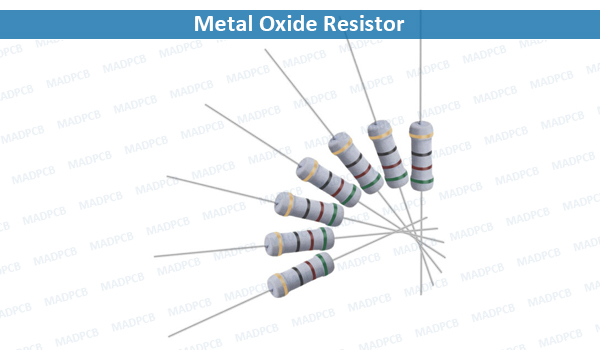What is a Metal Oxide Resistor?
A Metal Oxide Resistor (or Metal Oxide Film Resistor) is a fixed value, axial resistor which is made of ceramic rod that is coated with a thin film of metal oxides, such as tin oxide. Metal oxide film resistors must not be confused with metal oxide varistors, made of zinc oxide or silicon carbide.

Metal Oxide Film Resistor
Properties
Metal oxide resistors exceed the performance of metal film and carbon film resistors for the following properties: power rating, voltage rating, overload capabilities, surge capacity, and high temperature operation. Designers often choose the metal oxide film resistor for high endurance applications. Stability properties are inferior to metal film resistors. The metal oxide film resistors have poor properties for low values and tolerance. The temperature coefficient is around 300 ppm/°C, which is higher than for metal film types.
The resistance material for metal oxide resistors is tin oxide that is contaminated with antimony oxide to increase the resistivity. Metal oxide resistors can withstand higher temperatures than carbon or metal film resistors. The noise properties are similar to carbon resistors.
|
Max Operating Temperature Comparison |
|||
|
Material |
Carbon Film | Metal Film |
Metal Oxide |
|
Temperature |
200°C |
250-300°C (480-570°F) |
450°C |
Applications of Metal Oxide Resistors
Many properties of metal oxide film resistors are similar to metal film resistors. For basic use, metal film and metal oxide film are currently the predominant resistor types. Compared to carbon film, the prices are just as low. For applications where the power dissipation requirements are above 1 W and reasonable stability is required, carbon film resistors are more cost efficient than metal oxide film resistors.
Manufacturing
The metal oxide film is most often produced using chemical deposition methods. Almost always a ceramic carrier is used as substrate. The deposition process involves the reaction of a pure metal with a gas at high temperature and at a low pressure. A very common metal oxide film is tin oxide. The film is established by heating the resistor body in a tin chloride vapor.
Other metal oxide films usually employ a different deposition process. First, a thin metal film is applied. This film is then reacted with oxygen. The desired composition is achieved by measuring the resistance of a test piece.
After the film is applied to the resistor body, the final resistance value is achieved by applying a helical cut. This is usually done by laser cutting, while in the past it was done by grinding or sandblasting. The spiral cut makes the resistance path longer and of smaller cross section, and can increase the resistance value up to a thousand times greater than before the cut. The resistance value can be accurately controlled by the cutting. During the cutting process, the resistance is measured to allow for small corrections.
History
Metal oxide resistors were the first alternatives to carbon composition resistors. They used to be easier to manufacture than metal film resistors. Nowadays however, their use has decreased, and they have become less commonly used.
